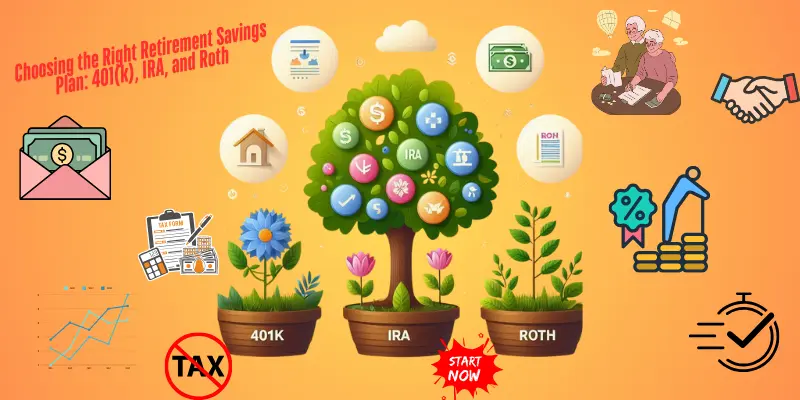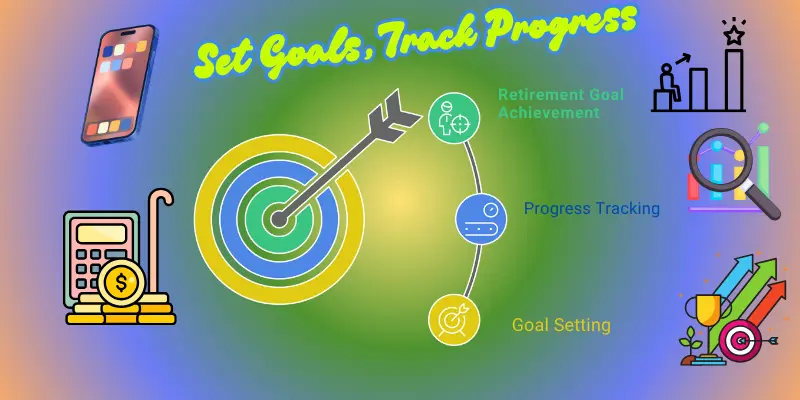Beginner’s Guide to Saving for Retirement: Essential Tips and Strategies to Secure your Future Today
Published: 27/03/2025
Imagine this scenario: you’re catching up with friends over coffee when the topic of retirement comes up. One friend mentions they’ve started saving, and you realize you haven’t even thought about it. Panic and confusion set in—where do you begin?
Retirement savings can seem daunting, but it’s simply about setting aside money now for a comfortable future. Starting early is key, even with small steps. 57% of U.S. retirees rely on Social Security, but only 38% of non-retirees expect it to be substantial. Compound interest turns small contributions into significant savings over time.
Why start now? Early savings lead to long-term growth and financial security. You don’t need a lot of money to begin; consistency is what counts. Small, regular contributions can make a big difference.
This guide is for young professionals, students, and financial beginners who want actionable steps to start saving for retirement without the financial jargon. We’ll break down everything from choosing the right account to setting realistic goals and tracking your progress.
Ready to take control of your financial future? Let’s dive in and build a solid foundation for your retirement today. Remember, every journey starts with a single step.
Start Early & Stay Consistent: Even modest savings can grow significantly over time with compound interest.
Use Diverse Strategies & Tools: Maintain financial health by utilizing tax-advantaged accounts, employer-sponsored plans, and regular budget reviews.
Plan, Automate & Adjust: Automate contributions, set realistic savings goals, and adjust your strategy periodically to stay on track.
Step 1: Understand Your Retirement Savings Options
When it comes to saving for retirement, the first step is choosing the right type of account. There are several options available, but the basics usually come down to three main types: 401(k), IRA (Traditional vs. Roth), and Roth 401(k). Here’s a simple breakdown:

401(k):
This is an employer-sponsored plan where you contribute a portion of your paycheck before taxes are taken out. It’s a common choice because many employers offer a matching contribution—free money!
Pros: Pre-tax contributions, employer match (free money!), higher contribution limits.
Cons: Limited investment options, and taxes are due when you withdraw funds in retirement.
IRA (Traditional):
This is an individual account that you open yourself, and your contributions are tax-deductible. It’s a great option if your employer doesn’t offer a 401(k).
Pros: Tax-deductible contributions, more investment options.
Cons: Contribution limits are lower than a 401(k), and you’ll pay taxes when you withdraw in retirement.
Roth IRA:
With a Roth IRA, you contribute after-tax money, but when you withdraw in retirement, it’s tax-free. It’s ideal if you expect to be in a higher tax bracket in the future.
Pros: Tax-free withdrawals in retirement, more investment options.
Cons: No tax deduction upfront, and income limits may apply.
Roth 401(k):
Similar to a 401(k), but contributions are made after taxes. This option is great if you want to make tax-free withdrawals in retirement.
Pros: Higher contribution limits than a Roth IRA, tax-free withdrawals in retirement.
Cons: Limited investment choices, and no immediate tax break.
If you’re just getting started, a 401(k) or IRA is usually the best way to go. These options are simple, accessible, and effective. Whether it’s employer-sponsored or individual, both give you the chance to grow your savings over time. Don’t stress about making it perfect—just pick one and get started!
Think of your retirement savings options like different plants in a garden. A 401(k) is a sturdy oak tree, providing long-term growth and stability. An IRA (Traditional vs. Roth) is a flowering shrub, offering diverse benefits. Just as selecting the right mix of plants helps your garden flourish, choosing the right savings options helps your financial future grow.
Step 2: Start Small, But Be Consistent
Consistency is key for retirement savings, not the initial amount. Small contributions grow over time due to compound interest. Imagine planting a tree: it starts small but grows tall with care. Today’s small contributions can turn into significant savings tomorrow.
Why Consistency is Key:
When it comes to saving for retirement, the key is consistency—not how much you contribute at the beginning. Even small contributions can grow significantly over time, thanks to compound interest. This means the money you earn on your investments earns even more money. Here’s a simple way to think about it:
- Imagine planting a tree. At first, it’s small, but over time, with proper care, it grows taller and stronger. The same thing happens with your retirement savings.
- Small contributions today can snowball into bigger savings tomorrow. The earlier you start, the more time your money has to grow.
Automating Your Savings:
One of the easiest ways to stay consistent is to automate your savings. Set up an automatic transfer from your paycheck or checking account directly to your retirement account. This way, you don’t have to think about it each month—it happens automatically.
For example, if you save just $50 per month, it might seem like a small amount, but over 10, 20, or 30 years, it can grow significantly with compound interest. Even if you can’t put aside hundreds of dollars each month, it’s important to start. Here’s a quick illustration of how consistent, small contributions can grow:
- $50 per month could grow into $35,000+ after 30 years, assuming an average return of 7% annually.
Starting with $50 per month is better than waiting until you can save larger amounts. The most important thing is to start now and be consistent. Small, regular contributions will make a big difference over time, and your future self will thank you!
Saving for retirement is like putting together a jigsaw puzzle. Each $50 you save is a puzzle piece. Initially, it might not look like much, but as you consistently add pieces, the picture becomes clearer and more complete. With time and patience, those small pieces create a beautiful, finished puzzle—your secure retirement.
Step 3: Take Advantage of Employer Matching Contributions
Employer matching contributions are like free money—maximize this benefit to boost your retirement savings effortlessly.
What is Employer Matching?
If your employer offers matching contributions to your retirement account, it’s like free money—seriously! Here’s how it works: Your employer will match a certain percentage of the money you contribute to your retirement account, up to a limit. For example, if you contribute 5% of your salary to your 401(k), your employer might match that with an additional 5%.
Why it matters:
This is essentially a bonus for saving for retirement. It’s money you would not get otherwise. So, if you’re not contributing enough to get the full match, you’re missing out on this “free money.
Maximizing Your Employer Match:
To make sure you’re getting the full benefit, follow these steps:
- Check your plan: Find out the details of your employer’s match (e.g., 100% match on the first 5% of your salary).
- Contribute at least the match percentage: If your employer matches up to 5%, make sure you’re contributing at least 5% of your salary.
- Automate your contributions: Set it up so that a portion of your paycheck goes straight into your retirement account, ensuring you don’t miss the match.
Example:
Let’s say you make $50,000 per year, and your employer matches 100% of your contributions up to 5%. If you contribute 5%, that’s $2,500 from you, and your employer will match it with another $2,500. That’s $5,000 being added to your retirement account—just for saving.
Never leave free money on the table. Always contribute enough to your retirement account to get the full employer match. It’s one of the easiest ways to boost your savings without doing much extra work!
Think of employer matching contributions like joining a double-dutch jump rope game. Your employer swings one rope (their contribution), and you swing the other (your contribution). By contributing enough to get the full match, you’re perfectly in sync, maximizing your jump (savings) and making the game (your retirement plan) more fun and rewarding.
Step 4: Set Realistic Goals and Track Your Progress
Set clear, manageable retirement goals and use tools to track your progress for consistent motivation and accountability.
How to Set Retirement Savings Goals:
Setting clear and measurable retirement goals is a great way to stay on track. It’s easier to stay motivated when you know exactly what you’re working towards. Start with small, manageable goals that you can achieve in the short term, like saving $1,000 by the end of the year. Once you reach that goal, set a new one! This approach helps build momentum and makes the process feel less overwhelming.

- Tip: Break down your goals into smaller monthly or quarterly targets. For example, saving $100 per month to reach your $1,000 goal in 10 months.
Using Tools to Track Progress:
To make sure you’re on track, use simple tools to monitor your progress. There are apps, spreadsheets, and retirement calculators that can help you keep tabs on your savings. Tracking your progress helps you stay accountable and shows how close you are to reaching your goals.
- Examples of tools: Apps like Mint or Personal Capital can help track your retirement savings. You can also use simple spreadsheets to set goals and track your contributions.
Tip: Use a goal-setting template to make it even easier. You can download a free retirement goal-setting template from various financial websites.
Example:
If your goal is to save $1,200 in a year, use a tracker to show how much you need to save each month (e.g., $100 per month). As you add funds, you’ll see your progress and can adjust if needed.
Set simple, realistic goals and monitor them regularly. By breaking big goals into smaller chunks and using tools to track your progress, you’ll stay on top of your retirement savings. Checking in on your progress helps you adjust if necessary and ensures you’re always moving in the right direction!
Setting and tracking retirement goals is like training for a marathon. You wouldn’t expect to run 26 miles on day one. Instead, you set small, achievable training goals (like saving $1,000 by the end of the year) and build up your endurance over time (consistent savings). Using tools to track progress is like monitoring your training plan—you see how far you’ve come and adjust as needed to reach the finish line (your retirement goal).
Step 5: Focus on Low-Cost, Beginner-Friendly Investments
Choose low-cost investments like index funds and ETFs to maximize your savings and minimize fees, ensuring more of your money works for you.
Why Low Fees Matter:
When you’re just starting out, it’s easy to overlook fees, but they can seriously eat into your long-term savings. High fees might seem small at first, but over time, they can add up and reduce the returns on your investment. As a beginner, you want to make sure that most of your money is working for you, not just going towards fees. The less you pay in fees, the more you have to invest and grow your savings.
Example:
Imagine you have a high-fee mutual fund charging 1.5% in fees each year. Over 20 years, those fees can add up to a lot of lost growth—potentially tens of thousands of dollars, depending on the size of your investments.
What are Low-Cost Investments?
Low-cost investments like index funds and ETFs (Exchange-Traded Funds) are excellent choices for beginners because they’re affordable and easy to manage. They track a broad market index, like the S&P 500, which means you’re investing in a wide range of companies with a single investment.
- Index Funds: These funds aim to replicate the performance of a specific market index. They usually have very low fees and are great for long-term growth.
- ETFs: Like index funds, ETFs track a market index, but they trade like stocks, giving you flexibility. They also tend to have low fees, making them perfect for beginner investors.
Example:
Let’s say you invested in two different funds over 20 years:
- High-fee mutual fund: Charges 1.5% annually and grows at an average of 7% per year.
- Low-cost index fund: Charges 0.1% annually and grows at an average of 7% per year.
Over the long term, the low-cost index fund would likely outperform the high-fee mutual fund, even though both have the same growth rate. Why? Because the fees in the high-fee fund eat into your potential returns.
To maximize your returns, stick with low-cost options like index funds or ETFs. These investment choices are not only beginner-friendly but also allow more of your money to grow over time, without being eaten up by high fees. The earlier you start with low-cost investments, the better off you’ll be in the long run!
Choosing low-cost investments is like shopping smart for groceries. Instead of buying expensive, branded items, you opt for quality store brands that cost less but provide the same nutritional value. By focusing on low-cost investments like index funds and ETFs, you’re getting great value without overspending, allowing more of your money to work for you.
Step 6: Build an Emergency Fund First
Protect your retirement by building an emergency fund today, so life’s surprises don’t derail your savings.
Why You Need an Emergency Fund:
Before diving headfirst into long-term retirement savings, it’s crucial to have an emergency fund in place. Life can throw unexpected expenses your way—like car repairs, medical bills, or job loss. If you don’t have an emergency fund, you may find yourself dipping into your retirement account to cover those costs, which can hurt your future savings.
Why it’s important:
An emergency fund gives you peace of mind, knowing that you can handle life’s surprises without putting your retirement at risk. It’s a safety net that allows you to keep your long-term goals on track while dealing with short-term challenges.
How to Build an Emergency Fund:
Start by setting aside a small, manageable amount each month. Aim for 3 to 6 months’ worth of living expenses as a target. But don’t feel like you have to hit that goal overnight. Start with whatever you can, and build it up over time.
Practical Steps:
- Step 1: Set a monthly goal—saving even a small amount consistently is key.
- Step 2: Use a high-yield savings account for your emergency fund to earn some interest while keeping the money accessible.
- Step 3: While saving for an emergency fund, continue saving for retirement—but prioritize your emergency fund first.
Example:
Let’s say you can save $100 per month for your emergency fund, and $50 per month for retirement. By the end of the year, you’ll have $1,200 for your emergency fund and $600 for retirement. Once your emergency fund is built up, you can shift more towards retirement savings.
Build an emergency fund first—it’s essential to have that financial cushion before focusing solely on long-term retirement savings. Once your emergency fund is set, you’ll be in a better position to focus on growing your retirement savings without worry!
Building an emergency fund is like constructing a solid foundation for a house. Before you can build the walls and roof (long-term retirement savings), you need a strong base (emergency fund) to support it. This foundation ensures that unexpected storms (surprise costs) don’t collapse the entire structure (your retirement plan).
Additional Considerations in Retirement Planning
Understanding Social Security
Social Security gives you a crucial income layer during retirement, but it only covers about 40% of your pre-retirement earnings. That’s why personal savings are essential if you want to maintain your lifestyle. Think of Social Security benefits as a supplement to your savings, not the main source.
Debt Management and Financial Fitness
Tackling high-interest debt frees up money for your retirement savings. Plus, staying fit now can lower future healthcare costs and extend your working years if you choose. These personal efforts can have big financial benefits down the line.
Planning for Inflation and Healthcare Costs
Living costs and healthcare expenses are set to rise over the years. Ensure your retirement fund can handle inflation by investing in assets like equities that typically outpace inflation. Also, consider setting aside funds specifically for healthcare or look into long-term care insurance for added security.
Practical Tools and Resources
In today’s digital age, there are tons of tools and resources to help with your retirement planning. Financial calculators can show you how your savings might grow, while budgeting apps help track your monthly expenses and find areas to cut back. Many online platforms also offer educational resources on investment strategies, diversification, and tax planning—key elements of a solid retirement plan.
| Tool / Resources | Description | Benefits |
| Retirement Savings Calculator | Estimates the future value of your retirement savings based on contributions, growth rate, and duration. | Helps in goal setting and progress tracking. |
| Budgeting Apps | Tracks your monthly income and expenditures, identifying opportunities to save more. | Provides real-time insights into spending patterns. |
| Investment Platforms | Offers access to stocks, bonds, mutual funds, and ETFs with diversified portfolios. | Enables the efficient management of investment assets. |
| Financial Advisor Services | Provides personalized financial planning and advice tailored to your unique circumstances. | Helps optimize tax strategies and investment plans. |
Using these tools not only gives you a clear picture of your progress but also helps you set realistic goals. The more you know about your financial health and investment options, the better you’ll be at fine-tuning your retirement strategy.
Mistakes to Avoid
Avoid common pitfalls like delaying savings, missing out on employer matches, and neglecting to reassess your goals regularly.
Not Starting Early Enough:
One of the biggest mistakes you can make when saving for retirement is waiting too long to get started. The longer you wait, the less time your money has to grow. Time is your biggest ally when it comes to retirement savings, thanks to compound interest. The earlier you start, even with small amounts, the more your money will grow over time.
Why it matters:
If you wait until your 30s or 40s, you miss out on years of growth. Starting early means you can take advantage of decades of compound interest, which gives you a bigger nest egg when retirement comes.
Overlooking Employer Contributions:
If your employer offers matching contributions, don’t leave that free money on the table! A lot of people forget about employer matches or don’t contribute enough to get the full match, which is a missed opportunity. It’s essentially “free money” for your retirement, and if you’re not taking full advantage of it, you’re losing out.
Tip: Always contribute enough to get the full employer match. Even if you can’t contribute a lot, the match will give you a boost.
Not Reassessing Goals Regularly:
It’s easy to set retirement goals and forget about them, but regularly reassessing your goals is key to staying on track. Life changes, and so can your financial situation. By reviewing your goals periodically, you can adjust your savings plan to match any changes in income, lifestyle, or unexpected events.
Tip: Set a reminder every 6 months or once a year to review your retirement goals and make adjustments if needed.
Getting Distracted by High-Cost Investments:
Many beginners get excited about fancy, high-fee investments that promise big returns. However, high-fee investments can take a huge chunk out of your returns over time. Even if an investment seems to be performing well, the fees can eat into your profits.
Tip: Stick with low-cost options, like index funds or ETFs, that keep fees low and help you maximize your returns. Don’t get distracted by investments that seem too good to be true.
Avoid these common mistakes by starting early, taking full advantage of employer matches, reassessing your goals regularly, and steering clear of high-fee investments. By staying on top of these key points, you’ll be in a much better position to secure your financial future!
Staying Motivated on Your Retirement Journey
Staying motivated for long-term retirement planning is crucial. Regularly remind yourself of the benefits, like financial freedom and pursuing your passions. Celebrate progress with small rewards or simple acknowledgments.
Join online communities where people share retirement strategies and success stories. Learning from others can provide practical tips and reinforce that saving consistently pays off. Periodically review your progress and celebrate the small victories leading to long-term success.
Your Future Starts Now: Take the First Step Toward a Secure Retirement
To sum it up, here are the key takeaways from this beginner’s guide to saving for retirement:
- Start early: The earlier you start saving, the more time your money has to grow through compound interest.
- Consistency is key: Small, regular contributions can add up significantly over time.
- Maximize employer contributions: Always contribute enough to get the full employer match—it’s free money!
- Set realistic goals: Break down big goals into smaller, manageable targets and track your progress.
- Invest in low-cost options: Choose investments with low fees, like index funds or ETFs, to maximize your returns.
- Build an emergency fund first: Make sure you have an emergency fund in place before focusing on long-term savings.
Don’t make the mistake of waiting too long to start saving. Even small amounts can grow over time, so get started now. Avoid high-fee investments that eat into your returns, and always reassess your retirement goals to stay on track.
Now that you have the tools to start saving for retirement, it’s time to take action! Start saving today, set up automatic transfers, and stay consistent. Don’t forget to subscribe to our newsletter for more tips on managing your finances, or share this post with someone who could benefit from these retirement-saving tips.
Your future self will thank you for the steps you take today. Start building your financial security now—you’ve got this!
The best time to start saving for retirement is now. The power of compounding can turn small, regular contributions into a substantial nest egg over time.Suze Orman
Saving Smarter: Answers to Your Most Common Retirement Questions
Yes, you can invest in stocks through your retirement account. However, beginners should consider safer, low-cost options like index funds or ETFs, which offer broad market exposure.
Build an emergency fund first to cover unexpected expenses without dipping into your retirement savings. Once that’s set, you can focus on saving for retirement.
Use tools like apps, spreadsheets, or retirement calculators to track your savings. Set small goals and check them regularly to make sure you’re on track.
Consider your risk tolerance, time horizon, and retirement goals. Consult with a financial advisor if needed.
Absolutely! Make the most of catch-up contributions available for those over 50 and consider increasing your savings rate.

- Be Respectful
- Stay Relevant
- Stay Positive
- True Feedback
- Encourage Discussion
- Avoid Spamming
- No Fake News
- Don't Copy-Paste
- No Personal Attacks



- Be Respectful
- Stay Relevant
- Stay Positive
- True Feedback
- Encourage Discussion
- Avoid Spamming
- No Fake News
- Don't Copy-Paste
- No Personal Attacks





